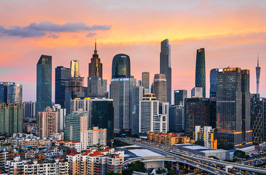Opportunities of Bay Area in focus
Governor says Guangdong will play its role well in demonstrating high-quality development
South China's Guangdong province has pledged to spare no effort in accelerating the construction of the Guangdong-Hong Kong-Macao Greater Bay Area and better leverage the role this can play in its economic development in 2024.
Wang Weizhong, governor of Guangdong, made the remarks when he delivered his government work report to the second session of the 14th Guangdong Provincial People's Congress, which opened in the southern metropolis of Guangzhou on Tuesday.
The provincial government has set the goal of a 5 percent GDP growth rate for Guangdong in 2024. Wang said the province will promote soft and hard connectivity with Hong Kong and Macao special administrative regions, and accelerate the construction of an advanced rail network to link cities in the Bay Area.
In addition to promoting the preliminary work of the Guangzhou-Zhuhai-Macao high-speed railway, relevant departments will speed up the reconstruction and expansion of the exit-entry land ports of Huanggang and Shatoujiao in Shenzhen, he said.
Meanwhile the provincial government will make use of the Hong Kong-Zhuhai-Macao Bridge to optimize and improve northbound travel for Hong Kong and Macao vehicle access programs while promoting "southbound travel for Guangdong vehicles "this year, Wang said.
He said that Guangdong will expand the list of "Bay Area standards" and the scope of "Bay Area certification" projects, and increase the functions of the Bay Area as a trade and shipping hub to strengthen the synergy and linkage between the construction of the Bay Area and major national development strategies.
Wang said Guangdong will accelerate high-quality development through advancing the construction of an international science and technology innovation center and the comprehensive national science center in the Bay Area.
"Focusing on industrial and technological cooperation, we will give full play to the leading role of the pilot free trade zones of Hengqin, Qianhai and Nansha and Shenzhen Park of the Hetao Shenzhen-Hong Kong Science and Technology Innovation Cooperation Zone to accelerate the creation of an important driving force for leading high-quality development," he said.
Located at the border between Shenzhen's Futian district and Hong Kong, the Hetao cooperation zone covers 3.02 square kilometers in Shenzhen in an area known as Hetao, and nearly nine-tenths of 1 sq km in Hong Kong.
The cooperation zone is regarded as an attractive and suitable place due to its strategic location, established infrastructure, business-friendly environment and innovation ecosystem.
Wang said the provincial government will also go all out to maintain the leadership in taking a Chinese development path to modernization.
"Starting from the development needs and people's expectations of Guangdong, Hong Kong and Macao, we will continue to promote cooperation in such areas as employment, education, healthcare and social security, and support Hong Kong and Macao to better integrate into the development strategy of the country," he said.
Wang said Guangdong must shoulder the responsibility of being one of the country's economic powerhouses.
He urged the prosperous cities of Guangzhou, Shenzhen, Foshan and Dongguan as well as other major economic cities to play a role in the province's overall economic development while other cities make efforts to catch up, contributing to Guangdong's high-quality development in 2024.
To this end, Guangdong will expand high-level opening-up to the world and try to build a new system of a higher-level open economy this year, he said.
While promoting high-quality development of the finance industry, Wang promised to deepen reform in key areas to build a market-oriented, legal and internationalized first-class business environment.
According to the governor, Guangdong — which registered 13.57 trillion yuan ($1.94 trillion) in GDP in 2023, up 4.8 percent year-on-year — plans to increase fixed-asset investment by 4 percent, lift total retail sales of consumer goods by 6 percent and lift foreign trade by 1 percent this year.
Guangdong's added value of industrial enterprises above designated size is projected to grow 5 percent. Grain production is estimated to hit 12.7 million metric tons in 2024.
Meanwhile, the province will create more than 1.1 million new urban jobs with the urban unemployment rate forecast to be around 5.5 percent this year.




 Print
Print Mail
Mail

